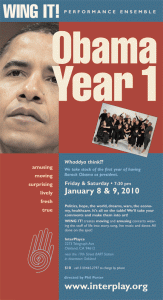
Recently a friend sent me a survey asking me what ensemble performance feels like. She’s getting her Ph.D. and she needed some help. Ever the dutiful friend, I complied.
I’ll share the text of those emails in a second. But first — I want to share this: I just finished performing in the second of two Wing It! Performance Ensemble concerts. I’ve been a member of Wing It for three years now and have had a love/hate relationship with performance.
Improvisational performance is hard and makes me feel vulnerable. Every Monday when it’s time to go to Wing It! practice, I feel shy and reticent. But I usually make myself go because I know it’s good for me. And I’m slowly falling in love with the community.
At this weekend’s performance, I still felt shy and reticent, but also READY! Good thing, because instead of the usual 12+ performers, we were only 8. This meant that I couldn’t just hide in the wings, waiting for other performers to initiate. I’d have to pay attention, be engaged, and start stuff!
For those of you who’ve never been to a Wing It performance, let me explain. We perform in a huge dance studio. The performers stand on the side, at attention. We watch, we wait, we listen. And when we’re inspired, we move onto the stage. We’ll dance, tell stories, or sing; we might even do all three at the same time! More simply, in the words of our fearless leader Phil Porter, “We start stuff, we mess with it, and then we end.”
The last couple nights we were performing on the theme of “Obama Year One.” Some gorgeous dances emerged, and stunning music played by Shazam, Theron, and Amar. Amidst the stories, we learned:
- How recent terrorism rules have restricted Phil’s ability to crochet on airplanes
- How I spontaneously learned to hoola hoop, taught by a group of Grandmas at Lake Merritt
- How Dorothy’s Filipina grandmother was detaind by INS on a recent visit to the US
Which brings me back to Nika’s question: “How would you describe, for someone who has never experienced it, what the experience of ensemble performance is like for you personally?” Here was my answer:
By myself, the listening is mostly introspective. I’m listening “in” to my story, and then listening to myself as I tell it. To some extent I’m also listening to the audience and their response to my story, but that’s it.
In ensemble performance, I’m stilling listening “in” to my own impulses, but I’m ALSO listening to the group as a whole. It’s a weird balance between going inside and staying focused outside.
But it’s also important to say that the outward focus is what we, in interplay, call “easy focus”. There’s no way to have a directed focus on one thing; instead my attention is diffused and peripheral, and takes in the whole. And then I choose from moment to moment: how do I want to respond to what’s happening?
In ensemble performance the question is no longer, “What am I creating?” but rather “What is being created here, and how can I contribute to it?
- Who are you as a performer? What are your personal riffs/motifs that you bring to the stage? (In order to be an excellent ensemble performer, I think it’s crucial that people understand their own individual offering… you can’t give to a group unless you know what you’re giving).
- Practice listening to the group body. Helping people become more and more “in tune” to the “middle thing” that is being created.
- Leading versus following. Know when to create something new/unique (to lead) and when to support that which has already been initiated (follow).
All in all, teaching and performing the InterPlay forms has been an intense and rewarding experience for me. Big hugs to all my fellow performers this weekend, and to all my Tuesday night students. What a journey we’re on together…listening, laughing, creating. It takes courage to be so vulnerable in public, and I salute us all.

Gretchen, remind me to teach about how to have focus and easy focus at the same time. smile. Cynthia